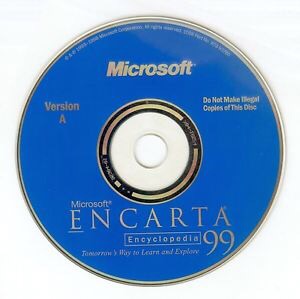 I was listening to a podcast last week, and one of the hosts as a joke suggested that he obtained all of his knowledge from Microsoft Encarta. I laughed at the multi-leveled humor of his statement, both that anyone would still use Encarta and that anyone ever did use Encarta as a primary source. However, hearing the name brought back memories, and also helped me make sense of a lot of what has happened in between.
I was listening to a podcast last week, and one of the hosts as a joke suggested that he obtained all of his knowledge from Microsoft Encarta. I laughed at the multi-leveled humor of his statement, both that anyone would still use Encarta and that anyone ever did use Encarta as a primary source. However, hearing the name brought back memories, and also helped me make sense of a lot of what has happened in between.
For my treasured millennial audience, let me explain. In the mid 1990s desktop computers began to come equipped with a Compact Disc Read Only Memory (CD ROM) Drive. These CDs could hold comparatively enormous amounts of data. Programs which in the past had taken multiple floppy discs to load now fit on a single disc. The size of this storage disc also allowed for the inclusion of audio and video clips that were never practically distributed prior to this innovation. The Internet was in its infancy for most users, and it was accessed by strangling dialup modems which made knowledge possible only to those willing to wait…and wait. For a brief moment, it appeared that the CD ROM was going to be the gateway to oceans of knowledge for all computer owners.
Into this sprung Encarta. Microsoft developed Encarta as a CD ROM encyclopedia and included it free with most purchases of new Windows computers with a CD ROM drive (one could cynically say that they were building the market for new devices by giving away media that only worked on the latest machines). Encarta was the future of the encyclopedia, easy to access, colorful, and including sound and video clips that could bring subjects to light. Why simply read about King’s “I have a dream” speech, when one could watch it in blurry video? Mozart’s biography would be accompanied by clips from his greatest symphonies. Articles about Vietnam could be illustrated with battlefield clips. The compact size, coupled with the new features that couldn’t be replicated even in venerated Encyclopedia Britannica made Encarta the clear path for the future. I remember early computer labs with machines equipped with Encarta amazing parents with the blurry MLK clip. Clearly education was going to be different.
But Encarta not only didn’t change the world, in the big scheme of things, it barely got used beyond the play stage. Everyone took Encarta out for a spin and they were amazed with its look, its sound, its tricks, but soon most found that they seldom if ever used it after this. Because the problem was that Encarta, for all of its amazing, status quo challenging abilities, was not a very good encyclopedia. A single disc could not hold nearly enough information to give articles the depth necessary even for cursory research (exacerbated by the space taken by video and sound) and later two-disc versions were cumbersome and even still were lacking the depth to create value. Even the video and audio clips were organized around a limited number of high-profile subjects and not uniformly available for less glitzy topics. In a variation of Twain’s “A classic is a book that perople praise but don’t read,” Encarta became the disc that everyone had but no one used.
Encarta’s failure was that it was simultaneously groundbreaking and not good enough. The subsequent history of online reference (including Wikipedia) shows that many of the features of Encarta were the direction of the future, but it’s fundamental lack of content and depth made it useless. In many ways it mirrored the CD-ROM itself, incredibly large storage for its time, but not nearly enough for the demand it was to face.
In the evolution of digital resources there have been other “Encarta enigmas” devices and programs that are so amazing that they appear to be a sure success, but they fade from impracticality or lack of interest, or they are quickly surpassed by something else. I think of this today because the new frontier of classroom technology is the digital space. Which of the tools in the “Maker spaces” will become the education tools of tomorrow, and which are exciting shiny “one hit wonders” that look amazing in demonstrations, but in practice do the same thing over and over and never evolve into a true multi-use tool?
As always, I welcome your comments.